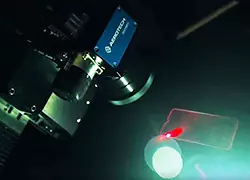What Is Motion Control Programming?
Motion control programming is the process of writing the software instructions that define and execute automated machinery’s precise physical...
Work with our team to determine which products or systems are the best fit for your application.
Some Aerotech products are available for immediate order in North America through our partner Motion Plus.

A case study examining display production that optimizes quality and throughput – and lower total cost.
A servo amplifier, commonly integrated within a servo drive, is the indispensable power electronic device used to provide the precise, conditioned electrical energy required to operate a servo motor. Its fundamental use is to act as the interface and execution mechanism between the motion controller’s low-power logic and the motor’s high-power needs.
It is the device that physically applies the corrective current necessary to maintain the motor's commanded position, velocity or torque in real time. This critical function is central to the technology of precision servo drives, which are essential components for achieving the highest standards of accuracy and stability in precision motion control applications.
A servo amplifier is used to control the power supplied to a servo motor, ensuring precise movement and positioning by regulating the exact amount of current delivered to the motor windings. It performs this function by translating the low-power command signals received from the motion controller into high-power current. This translation is not just simple amplification; it includes fast, accurate control of the current loop to ensure the motor generates the exact torque requested, irrespective of varying back-EMF or resistance.
A primary benefit of this real-time current regulation is disturbance rejection, which is crucial for maintaining performance in dynamic environments where external forces, friction changes or vibrations constantly threaten to push the motor off its intended path. By continuously adjusting the current, the amplifier helps stabilize the system and maintains deterministic motion quality.
The difference between a servo controller and an amplifier is defined by their functional role within the control hierarchy: one is the brain and the other is the muscle/reflex.
Servo Controller (Brain): The controller generates the high-level command signals, defines the motion trajectory, performs complex path planning (kinematics) and closes the outermost control loop (position loop). It decides where the motor should go based on the desired performance and feedback data.
Servo Amplifier (Muscle/Bridge): The amplifier (drive) takes the low-power command from the controller and physically amplifies the signal to drive the motor, acting as a bridge between the controller and the motor. The amplifier often contains the high-speed current loop and sometimes the velocity loop, executing the immediate, high-bandwidth force commands.
Understanding the role of a PID controller can help clarify the interaction between these components. The controller determines the overall PID parameters for the position loop, while the amplifier executes the current loop (the inner, fastest loop) to ensure the motor accurately delivers the torque commanded by the outer loops.
A servo motor is a linear or rotary motor that, when combined with an external feedback device (typically an optical encoder) and a drive, allows for precise control of position, velocity and acceleration. Servo motors are distinct from stepper motors because they operate under continuous closed-loop control.
The drive is the electronic device that powers the servo motor. It often includes the amplifier and a high-speed PID controller to close the servo loop around the motor's current and velocity. The drive receives motion commands and uses the feedback signal to regulate the power output to the motor.
For enhanced accuracy, a linear encoder can be used for feedback directly from the stage (load-side) rather than just the motor (motor-side), enhancing the accuracy of the system by measuring position closer to the work point and reducing measurement errors.
Closed-loop control is necessary when motion control applications require high precision and accuracy, or when the system is subjected to dynamic or varying external loads. It is the essential requirement for any servo system where verifiable performance is needed.
The need for closed-loop arises because it continuously monitors the output (actual position) via feedback devices and adjusts the input (current/torque command) to minimize errors due to external disturbances (e.g., friction changes, temperature drift, external forces). This correctional capability provides significantly better performance than an open loop system that relies only on feedforward gains and assumes the motor perfectly follows the command.
In applications such as laser cutting, inspection and robotics, the ability to instantly correct for error is non-negotiable. Therefore, in contrast to an open-loop control system, closed loop systems are better at handling disturbances, ensuring the deterministic execution of the motion profile.
Have questions about precision motion control? Ask our experts!
Motion control programming is the process of writing the software instructions that define and execute automated machinery’s precise physical...
Motion control software is the indispensable digital operating system that transforms abstract automation goals into real-world, precisely...
Motion control is a specialized field within automation engineering that focuses on the coordinated, controlled movement of mechanical systems. At...